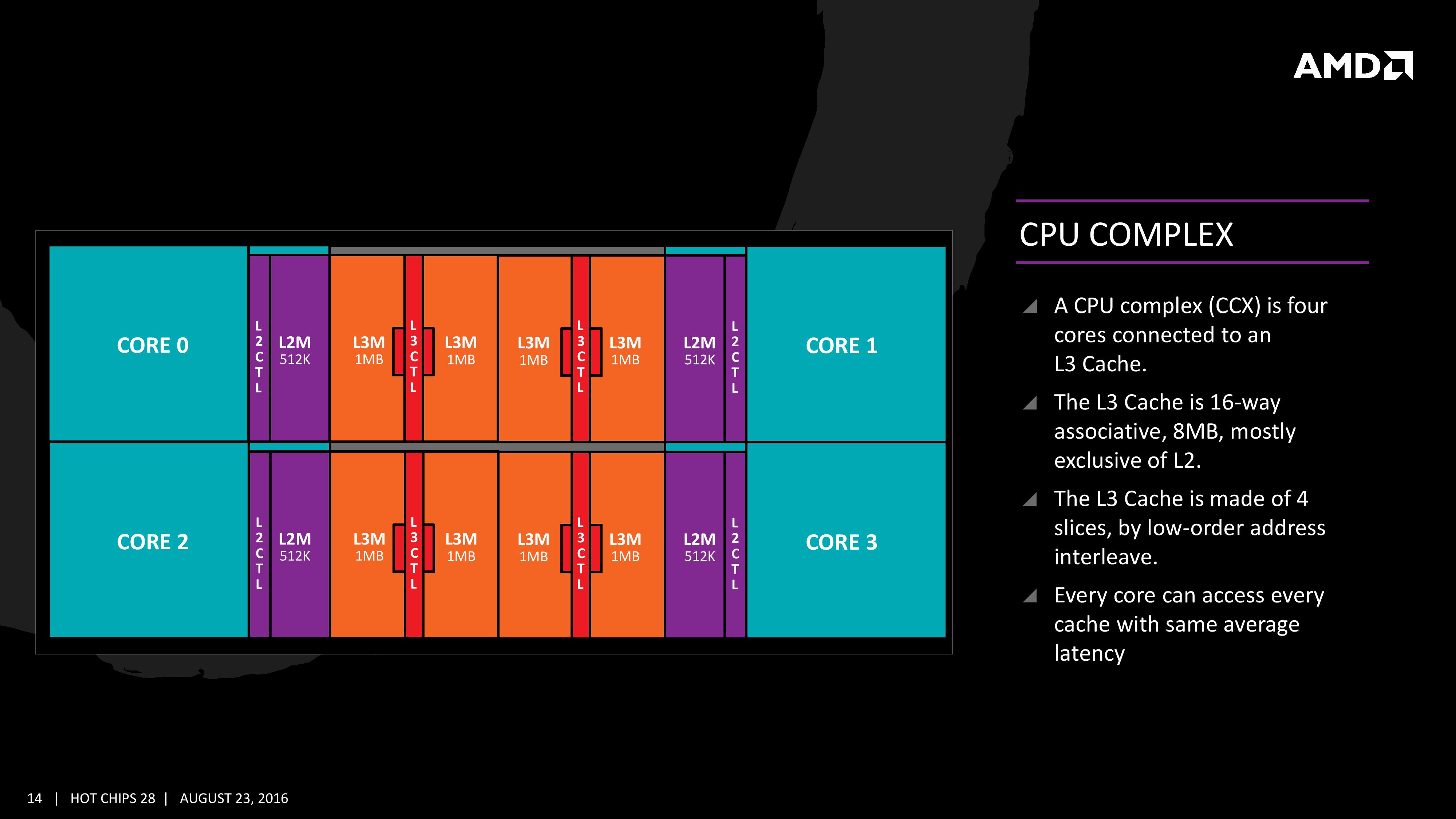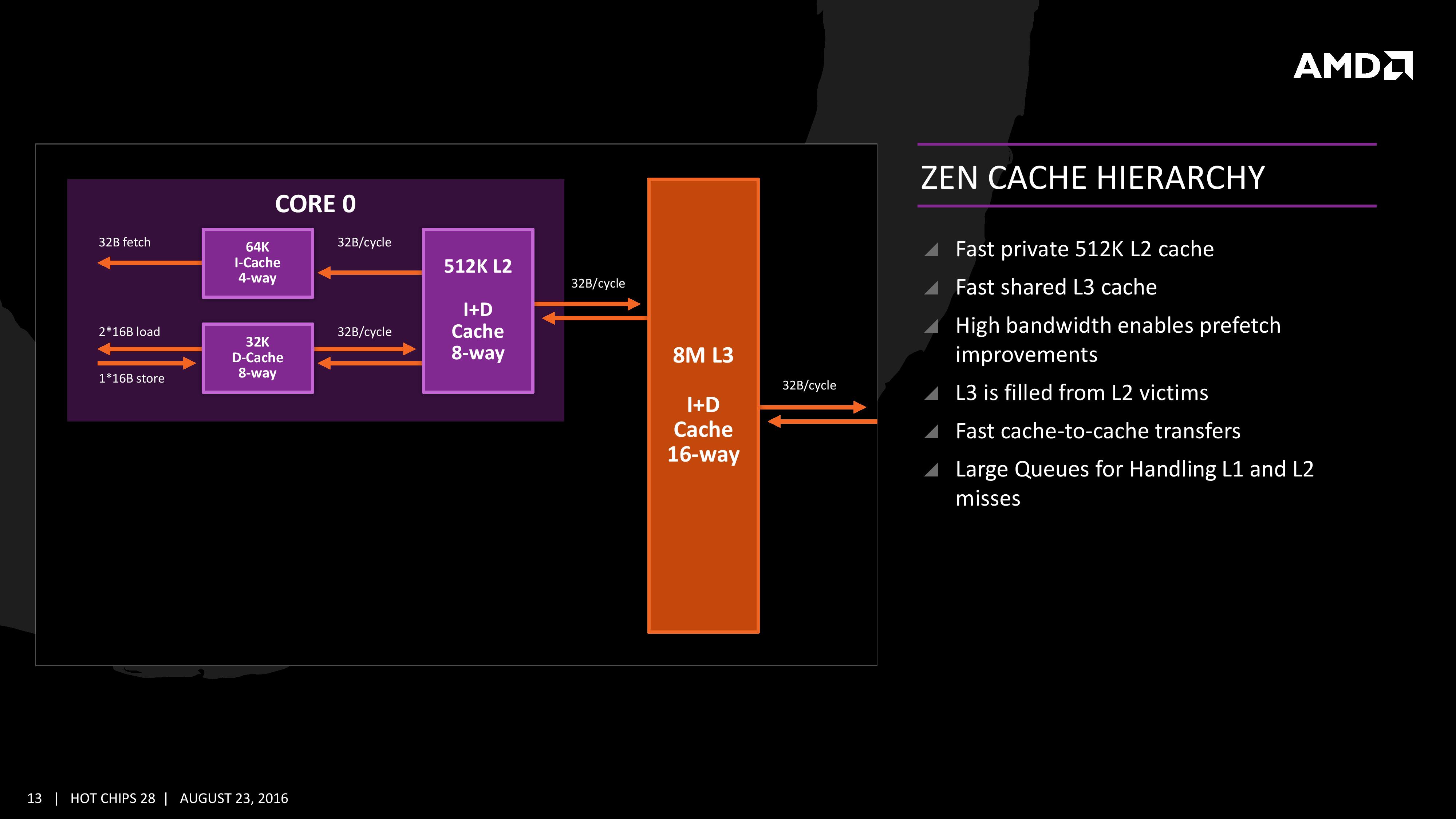AMD Zen Microarchiture Part 2: Extracting Instruction-Level Parallelism
by Ian Cutress on August 23, 2016 8:45 PM EST- Posted in
- CPUs
- AMD
- x86
- Zen
- Microarchitecture
The Core Complex, Caches, and Fabric
Many core designs often start with an initial low-core-count building block that is repeated across a coherent fabric to generate a large number of cores and the large die. In this case, AMD is using a CPU Complex (CCX) as that building block which consists of four cores and the associated caches.
Each core will have direct access to its private L2 cache, and the 8 MB of L3 cache is, despite being split into blocks per core, accessible by every core on the CCX with ‘an average latency’ also L3 hits nearer to the core will have a lower latency due to the low-order address interleave method of address generation.
The L3 cache is actually a victim cache, taking data from L1 and L2 evictions rather than collecting data from prefetch/demand instructions. Victim caches tend to be less effective than inclusive caches, however Zen counters this by having a sufficiency large L2 to compensate. The use of a victim cache means that it does not have to hold L2 data inside, effectively increasing its potential capacity with less data redundancy.
It is worth noting that a single CCX has 8 MB of cache, and as a result the 8-core Zen being displayed by AMD at the current events involves two CPU Complexes. This affords a total of 16 MB of L3 cache, albeit in two distinct parts. This means that the true LLC for the entire chip is actually DRAM, although AMD states that the two CCXes can communicate with each other through the custom fabric which connects both the complexes, the memory controller, the IO, the PCIe lanes etc.
One interesting story is going to be how AMD’s coherent fabric works. For those that follow mobile phone SoCs, we know fabrics and interconnects such as CCI-400 or the CCN family are optimized to take advantage of core clusters along with the rest of the chip. A number of people have speculated that the fabric used in AMD’s new design is based on HyperTransport, however AMD has confirmed that they are not using HyperTransport here for Zen. More information on the fabric may come out as we nearer the launch, although this remains one of the more mysterious elements to the design at this stage.
The cache representation in the new presentation at Hot Chips is almost identical to that in midweek, showing L1 and L2 in the core with 8MB of L3 split over several cores. AMD states that the L1 and L2 bandwidth is nearly double that of Excavator, with L3 now up to 5x for bandwidth, and that this bandwidth will help drive the improvements made on the prefetch side. AMD also states that there are large queues in play for L1/L2 cache misses.












106 Comments
View All Comments
atlantico - Friday, August 26, 2016 - link
Wow looncraz!! Really cool effort you made :)Spunjji - Saturday, August 27, 2016 - link
You numbers are different to everyone else's. Given that you don't cite any of your sources I believe everyone else.Krysto - Wednesday, August 24, 2016 - link
I would hope they try to double the cores of Intel for notebooks.Dual-core Zen without SMT will DESTROY Intel's Atom-based Celerons and Pentiums at the low-end. There will be absolutely ZERO reason to get a Celeron or Pentium notebooks once Zen appears on the market at that price range.
But at the Core i3 and Core i5 levels, I was hoping AMD would price a quad-core Zen with no SMT against dual-core Core i3 and Core i5, and a quad-core Zen with SMT against Intel's quad-core (no HT) Core i5, and finally 8-core with and without SMT variants against Intel's quad-core Core i7 chips (with HT).
If they can basically double the cores compared to what Intel has to offer at around the same price level, and maybe with only slightly worse single-thread performance and slightly worse power consumption, AMD's chips should be a NO-BRAINER. The value would be incredible, and it would push the market towards having powerful quad-core chips by default for most PCs. Intel is going to HATE that, because it would seriously cut into their profits. So AMD could use that strategy to both offer great value products and hurt Intel significantly.
looncraz - Wednesday, August 24, 2016 - link
AMD is not seeking the low end, they are trying to redefine AMD as the top-tier CPU company they once were. They are aiming for the top and the bulk of the market.Zen+'s 15% IPC improvement over Zen might just give them the performance crown, but I'm sure Intel has taken note and planned accordingly.
zaza - Wednesday, August 24, 2016 - link
but the AMD CCX module is a quad core module. i am not sure if it is easy for AMD to just remove two.looncraz - Wednesday, August 24, 2016 - link
Very easy, you just fuse off the defective core, that's the beauty of independent cores. The core complex just shares a common data bus and third level cache. Disabling a core in the complex will simply have it not ask for data on the common data bus. The L3 cache may or may not be cut down (probably will be).H2323 - Wednesday, August 24, 2016 - link
"While Zen is initially a high-performance x86 core at heart, it is designed to scale all the way from notebooks to supercomputers, or from where the Cat cores (such as Jaguar and Puma) were all the way up to the old Opterons and beyond, all with at least +40% IPC."https://www.youtube.com/watch?v=eUSJfGehKDQ
In the video its more than 40% across all of internal texting.
Vigilant007 - Saturday, August 27, 2016 - link
I don't know if AMD will ever have a major win as far as the PC industry again. Realistically they'll end up focusing on building custom x86 for consoles, and server chips. I can also see them exploiting their ability to do x86 to design custom chips for Apple.AMD could end up being a fantastic acquisition target as well.
Tuna-Fish - Tuesday, August 23, 2016 - link
From page 3:> and L2 with 512 entries and support for 4K and 256K pages only.
Surely you meant 4k and 2MB pages only?
deltaFx2 - Tuesday, August 23, 2016 - link
Ian, an error here: "It also states that the L3 is mostly inclusive of the L2 cache, which stems from the L3 cache as a victim cache for L2 data." A victim L3 is by definition an exclusive cache (as you note elsewhere). Also I don't understand why you have the impression that a victim cache is less efficient than an inclusive cache. As you note, an inclusive cache has to keep duplicate copies of data in L2 and L3 whereas an exclusive cache stores exactly 1 copy (either L2 or L3 but never both). In an exclusive cache hierarchy, a cache block is inserted into the L2, and when evicted, is put into the L3. In an inclusive cache hierarchy, a cache block is inserted both into the L2 and L3. Doesn't the exclusive hierarchy make better use of space? Incidentally, AMD has done exclusive caches since K8 at least. This isn't new.